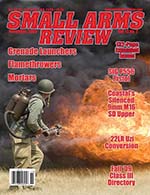By John Brown
In earlier articles we have alluded to the strong increase in the number of forms that are being processed by the NFA Branch. We have been working closely with the new Branch Chief, Steven Albro, to track all of the activities associated with forms processing and once again take an inside track to see what the industry can do to assist in managing the inputs to the process. Many of you who regularly read our information have seen that we continue to make suggestions on what we can do to better provide cleaner input to the examiners in processing forms. At this writing the normal processing time for Form 4s has now crept into the 120 day range and we have all been concerned as to what exactly is causing the slip. Most of you will remember two years ago when a Form 4 was taking about 22 days to process and Form 3s were actually back in dealers hands within a week of submission. With that kind of history the NFATCA wanted to, once again, dig in and get the details on the numbers.
We wanted to keep everyone up to date on the processing times and what is happening to try and improve the total process. With this article and our new web site, www.nfaformstats.com, we will continue to work closely with the NFA Branch and establish a live tracking mechanism to allow our readers and web miners to keep an accurate track of what is happening to processing times for all forms. Believe me when I tell you that the NFA Branch in Martinsburg is smoking hot in the productivity. The chief problem, as you will see in the charts, is the industry has nearly doubled the number of forms that we have submitted in the past three years. Put that into perspective with the fact that the NFA Branch is working with the same number of examiners three years later and it should not be a surprise to anyone that the processing times have slowed down. Steven Albro has instituted a ton of new procedures to better organize the processing and to improve the efficiency of the entire program. The NFATCA has and will continue to meet with Steve and the examiners to find better methods that the industry can comply with to improve inputs to the program. As we better define and get to the things that we can do to help the Branch we will post those to the site to assist everyone in their efforts to polish the input that we the industry provide to the NFA Branch.
We will begin a series of articles to address each of the forms that the NFA Branch receives from the industry. With each form we will cover the specific issues that the examiners find that slow the process of approving the forms. We will begin with the Form One and work our way through the entire contents of all of the forms that are submitted by the industry. In addition to pointing out the problems that ATF is having with industry submissions on particular forms we will also address on the www.nfafomrstats.com website the specifics of these issues so that this information is continuously available to anyone that wants assistance with forms submissions.
As we continue to look into what the industry can do to improve forms processing, we wanted to take this opportunity to point out some of the major accomplishments of the NFA examiners. In May of 2009, the NFA Branch processed some 7,742 forms topping that again in June with a record 9,219 forms. Top Gun examiner for the month of June processed a total of 1,400 forms in June. This number, by the way, was the third month in a row that examiners and the Branch had broken all previous records for forms processing. It is time for the industry to realize that even in the face of an uncertain economy you would never realize NFA buying is down.
To keep everyone better informed on just how busy the NFA Branch is, the chart on the previous page was issued in late July to initiate the tracking that they will use to provide you and the industry with a constant flow of information on how this work is progressing.
Please keep in mind that with the work flow, the NFA Branch has become a well oiled machine that runs very smoothly on its own. Like a pot of boiling water, removing the lid to take a look just means that it takes longer for the water to boil. My point with this analogy is DO NOT CALL unless you absolutely have to. Calling simply slows the entire process. If we do the math on calling let’s just say 12 examiners get three calls an hour at three minutes per call. That is a total of nearly two examiners time that gets pushed off onto an activity aside from processing forms. This estimate by the way is low. Please remember, calling only slows the process.
Time to join the ranks of the NFATCA, wouldn’t you say? Log on today at www.nfatca.org and join us today.
This article first appeared in Small Arms Review V13N2 (November 2009) |
| SUBSCRIBER COMMENT AREA |
Comments have not been generated for this article.



